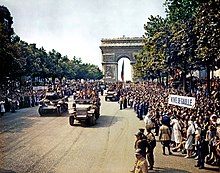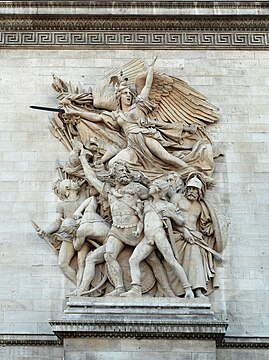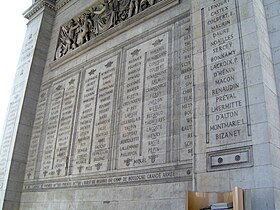| Arc de Triomphe | |
|---|---|
 | |
 | |
| Alternative names | Arc de Triomphe de l'Étoile |
| General information | |
| Type | Triumphal arch |
| Architectural style | Neoclassicism |
| Location | Place Charles de Gaulle (formerly Place de l'Étoile) |
| Coordinates | 48°52′25.6″N2°17′42.1″E / 48.873778°N 2.295028°E |
| Construction started | 15 August 1806 [1] |
| Inaugurated | 29 July 1836 [2] |
| Height | 50 m (164 ft) |
| Dimensions | |
| Other dimensions | Wide: 45 m (148 ft) Deep: 22 m (72 ft) |
| Design and construction | |
| Architect(s) | Jean Chalgrin Louis-Étienne Héricart de Thury |
The Arc de Triomphe de l'Étoile, [a] often called simply the Arc de Triomphe, is one of the most famous monuments in Paris, France, standing at the western end of the Champs-Élysées at the centre of Place Charles de Gaulle, formerly named Place de l'Étoile—the étoile or "star" of the juncture formed by its twelve radiating avenues. The location of the arc and the plaza is shared between three arrondissements, 16th (south and west), 17th (north), and 8th (east). The Arc de Triomphe honours those who fought and died for France in the French Revolutionary and Napoleonic Wars, with the names of all French victories and generals inscribed on its inner and outer surfaces. Beneath its vault lies the Tomb of the Unknown Soldier from World War I.
Contents
- History
- Construction and late 19th century
- 20th century
- 21st century
- Design
- Monument
- Tomb of the Unknown Soldier
- Details
- Access
- Replicas
- See also
- Notes
- References
- External links
The central cohesive element of the Axe historique (historic axis, a sequence of monuments and grand thoroughfares on a route running from the courtyard of the Louvre to the Grande Arche de la Défense), the Arc de Triomphe was designed by Jean Chalgrin in 1806; its iconographic programme pits heroically nude French youths against bearded Germanic warriors in chain mail. It set the tone for public monuments with triumphant patriotic messages. Inspired by the Arch of Titus in Rome, Italy, the Arc de Triomphe has an overall height of 50 m (164 ft), width of 45 m (148 ft) and depth of 22 m (72 ft), while its large vault is 29.19 m (95.8 ft) high and 14.62 m (48.0 ft) wide. The smaller transverse vaults are 18.68 m (61.3 ft) high and 8.44 m (27.7 ft) wide.
Paris's Arc de Triomphe was the tallest triumphal arch until the completion of the Monumento a la Revolución in Mexico City in 1938, which is 67 m (220 ft) high. The Arch of Triumph in Pyongyang, completed in 1982, is modeled on the Arc de Triomphe and is slightly taller at 60 m (197 ft). The Grande Arche in La Défense near Paris is 110 metres high, and, if considered to be a triumphal arch, is the world's tallest. [6]





















































